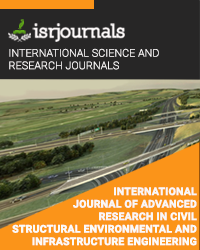experimental analysis on removal of odour from landfill mass
S.Rajavel Vinayagam,V.L. Baalaganapathy
Published in International Journal of Advanced Research in Civil,Structural,Environmental and Infrastructure Engineering and Developing
ISSN: 2320-723X Impact Factor:1.7 Volume:3 Issue:1 Year: 01 March,2017 Pages:289-291

Abstract
: Biogas methane requires appropriate filtration to minimize the corrosively effects of sulfide on the general infrastructure. In this work, a lab scale bioreactor inoculated with photosynthetic green sulfur-oxidizing bacteria was evaluated to its potential to remove headspace sulfide. Anaerobic green sulfur-oxidizing bacteria were isolated from a local swine waste pit and induced to grow over time on a sulfide-rich culturing media. 1-L glass batch reactors were used to mimic the removal of hydrogen sulfide from biogas stream. A negative control inoculated with non-sulfur oxidizing bacteria consortium was used to discern abiotic losses. Removal efficiencies of 100 to 95% were obtained for sulfide concentrations ranging from 610 to 1,200 ppmV, respectively. Interestingly, the prompt sulfide removal rate observed (i.e. < 5 minutes) encouraged further expectations of engineered biofiltering systems to remove sulfide from biogas stream at field scale.
Kewords
green sulfur-oxidizing bacteria, hydrogen sulphide, sulfide concentrations, engineered biofiltering systems.
Reference
[1] Lastella, G., C. Testa, G. Cornacchia, M. Notornicola, F.Voltasio and V.K. Sharma. 2002. Anaerobic digestion of semi-solid organic waste: Biogas production and its purification. Energy Conversion and Management 43: 63-75. [2] Tchobanoglous, G., F.L. Burton and H.D. Stensel. 2003. Wastewater Engineering. Treatment and Reuse, 4th edition. McGraw-Hill Companies, New York, NY. Cap. 14: 1505-1532. [3] Gabriel, D. and A.M. Deshusses. 2003. Retrofitting existing chemical scrubbers to biotrickling filters for H2S emission control. In Proceedings of the National Academy of Science of the United States of America 100(11): 6308–6312. [4] Syed, M., G. Soreanu, P. Falletta and M. Béland(2006). Removal of hydrogen sulfide from gas streams using biological processes - A review. Canadien Biosystems Engineering, 48, 2.1-2.14. [5] Van Niel, C.B. 1931. On the morphology and physiology of the purple and green sulfur bacteria. Archiv fur Mikrobiologie 3: 1-112. [6] Pfennig, N. Rhodopseudomonas globiformis, sp. n., a new species of the Rhodospirillaceae. Arch. Microbiol., 10 (1974), pp. 197–206.

